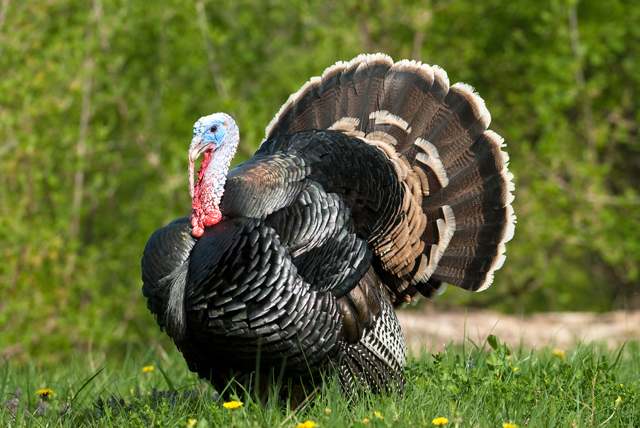
As Thanksgiving approaches, you might be thinking about what size turkey you should buy for your family’s feast or how you’ll cook this year’s turkey. But turkeys are more than holiday meals. They’re rather interesting animals — especially wild turkeys. Today let’s take a closer look by exploring some fun facts about these beautiful birds.
Here are ten facts about turkeys you might not have known.
- A turkey’s body has between 5000 and 6000 feathers. A female turkey’s feathers tend to be brown for concealment (so they can safely stay in the nest with their eggs) while males have more colorful plumage that lets them show off and attract mates. [source]
- While wild turkeys thrive in the U.S. today, they were near extinction as recently as the 1930s. [source]
- Benjamin Franklin proposed the wild turkey as the national bird of the United States (although the ultimate choice was the bald eagle). [source]
- Turkeys are intelligent birds. Not only can they recognize other turkeys by their voices, but they can learn the geography of an area covering more than 1000 acres. [source]
- Wild turkeys can fly up to 55 miles per hour, although only for short distances. [source]
- Turkeys are also reasonably fast on the ground, able to run up to 25 miles per hour. [source]
- The gobble sound a wild turkey makes can be heard from around a mile away. [source]
- Like humans, wild turkeys are omnivores, eating both plant-based food like grass and berries as well as insects and even small reptiles. [source]
- Only female turkeys care for their young, and that care only lasts briefly. After a few days, the chicks (with 4-17 eggs laid in a short period) learn to feed themselves. [source]
- Unlike some animals (like deer), overpopulation is not a problem with wild turkeys. They can live in large groups without doing serious damage to the environment because of their diverse food sources. Because they’ll eat using several plant and animal sources, they don’t deplete any one of them completely as other animal populations might. [source]

Where I live it’s rare to see wild turkeys, but I see some once a year when I’m lucky. They’re big, gorgeous birds that you might find coming out of the woods to feed or even crossing a street with their chicks. Do larger wild turkey populations exist where you live? What do you think of them? Did you learn anything new about turkeys from this collection of fun facts? Let us know in the comments below.













